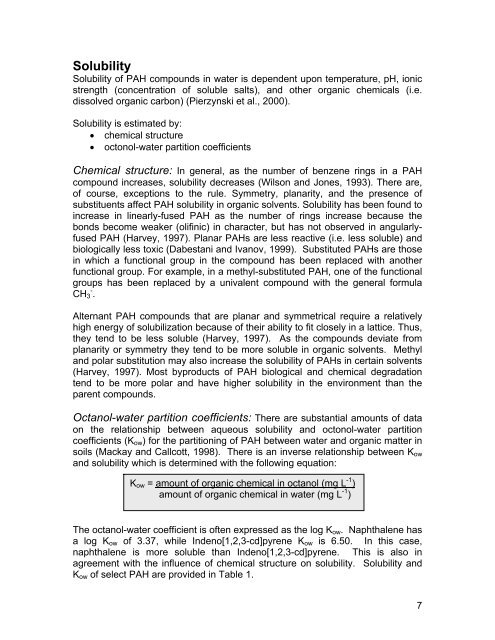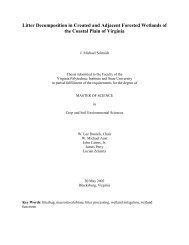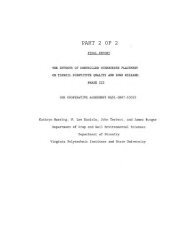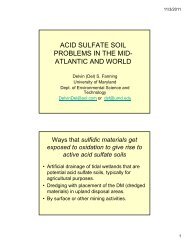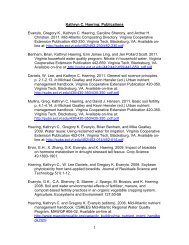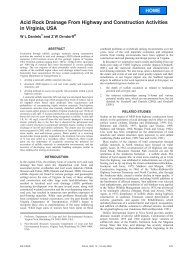Remediation of PAH-Contaminated Soils and Sediments: A ...
Remediation of PAH-Contaminated Soils and Sediments: A ...
Remediation of PAH-Contaminated Soils and Sediments: A ...
Create successful ePaper yourself
Turn your PDF publications into a flip-book with our unique Google optimized e-Paper software.
Solubility<br />
Solubility <strong>of</strong> <strong>PAH</strong> compounds in water is dependent upon temperature, pH, ionic<br />
strength (concentration <strong>of</strong> soluble salts), <strong>and</strong> other organic chemicals (i.e.<br />
dissolved organic carbon) (Pierzynski et al., 2000).<br />
Solubility is estimated by:<br />
� chemical structure<br />
� octonol-water partition coefficients<br />
Chemical structure: In general, as the number <strong>of</strong> benzene rings in a <strong>PAH</strong><br />
compound increases, solubility decreases (Wilson <strong>and</strong> Jones, 1993). There are,<br />
<strong>of</strong> course, exceptions to the rule. Symmetry, planarity, <strong>and</strong> the presence <strong>of</strong><br />
substituents affect <strong>PAH</strong> solubility in organic solvents. Solubility has been found to<br />
increase in linearly-fused <strong>PAH</strong> as the number <strong>of</strong> rings increase because the<br />
bonds become weaker (olifinic) in character, but has not observed in angularlyfused<br />
<strong>PAH</strong> (Harvey, 1997). Planar <strong>PAH</strong>s are less reactive (i.e. less soluble) <strong>and</strong><br />
biologically less toxic (Dabestani <strong>and</strong> Ivanov, 1999). Substituted <strong>PAH</strong>s are those<br />
in which a functional group in the compound has been replaced with another<br />
functional group. For example, in a methyl-substituted <strong>PAH</strong>, one <strong>of</strong> the functional<br />
groups has been replaced by a univalent compound with the general formula<br />
CH3 - .<br />
Alternant <strong>PAH</strong> compounds that are planar <strong>and</strong> symmetrical require a relatively<br />
high energy <strong>of</strong> solubilization because <strong>of</strong> their ability to fit closely in a lattice. Thus,<br />
they tend to be less soluble (Harvey, 1997). As the compounds deviate from<br />
planarity or symmetry they tend to be more soluble in organic solvents. Methyl<br />
<strong>and</strong> polar substitution may also increase the solubility <strong>of</strong> <strong>PAH</strong>s in certain solvents<br />
(Harvey, 1997). Most byproducts <strong>of</strong> <strong>PAH</strong> biological <strong>and</strong> chemical degradation<br />
tend to be more polar <strong>and</strong> have higher solubility in the environment than the<br />
parent compounds.<br />
Octanol-water partition coefficients: There are substantial amounts <strong>of</strong> data<br />
on the relationship between aqueous solubility <strong>and</strong> octonol-water partition<br />
coefficients (Kow) for the partitioning <strong>of</strong> <strong>PAH</strong> between water <strong>and</strong> organic matter in<br />
soils (Mackay <strong>and</strong> Callcott, 1998). There is an inverse relationship between Kow<br />
<strong>and</strong> solubility which is determined with the following equation:<br />
Kow = amount <strong>of</strong> organic chemical in octanol (mg L -1 )<br />
amount <strong>of</strong> organic chemical in water (mg L -1 )<br />
The octanol-water coefficient is <strong>of</strong>ten expressed as the log Kow. Naphthalene has<br />
a log Kow <strong>of</strong> 3.37, while Indeno[1,2,3-cd]pyrene Kow is 6.50. In this case,<br />
naphthalene is more soluble than Indeno[1,2,3-cd]pyrene. This is also in<br />
agreement with the influence <strong>of</strong> chemical structure on solubility. Solubility <strong>and</strong><br />
Kow <strong>of</strong> select <strong>PAH</strong> are provided in Table 1.<br />
7


